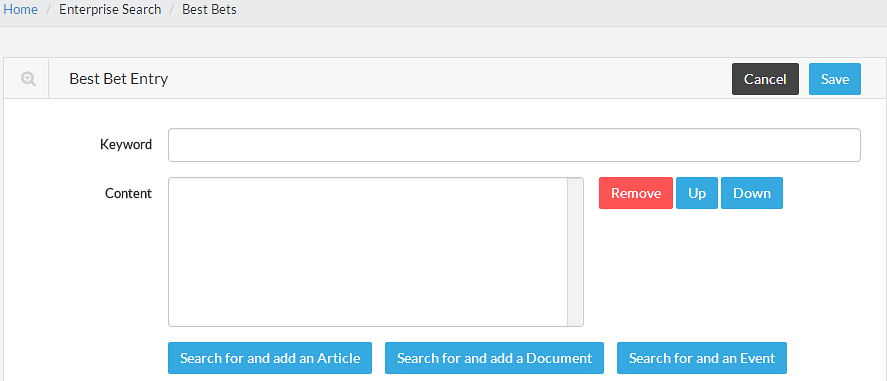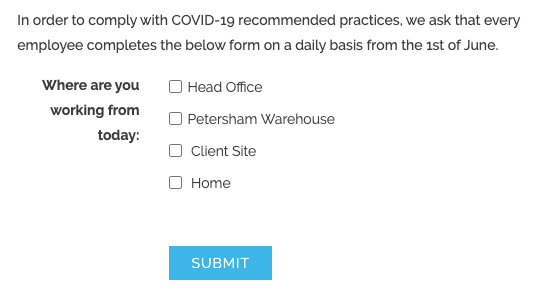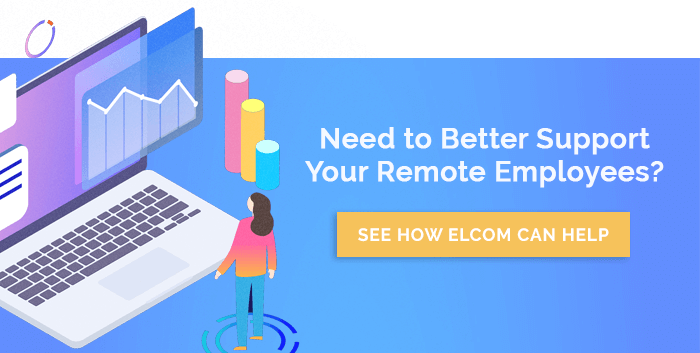We've seen organisations rise to the challenge of supporting the majority of their employees working remotely from home.
And with this, a subsequent surge in intranet usage, with organisations tapping into the essential digital workplace tools available to help keep people informed and engaged, despite the barrier of physical distance.
It’s been interesting to observe how different organisations we work with, including those in the same industries, have met the needs of their frontline and remote workforce with various intranet features and functions. We've noticed that the same features can foster different communication styles according to the preferences of the business's employees.
Below are some of these insights to inspire you to overcome key remote working challenges. This will help you create a game plan to better leverage your intranet to improve internal communications, knowledge management, workforce engagement and employee collaboration within your own workplace.
Dedicated Information Pages
Besides emails this is the most frequently used approach to sharing communications across all organisations that we've seen. Accessing up-to-date contextually relevant information is now more important than ever as employees continue to work remotely from different locations and at different times.
Having a dedicated, single source of truth is key. Microsoft Outlook, Slack and other internal communications channels can be used to announce information or communications, but should link to sections, pages, documents, forms and other resources on the intranet. This ensures all employees know where to go to access the latest, accurate version of resources - aka your single source of truth.
Also, keep in mind that people may be using their own personal laptops and other smart devices while working remotely, either from home or another location, and these dedicated information pages need to be optimised for smaller screens.
How This Works:
Depending on your own workforce, consider how information and communication should be grouped. What documents, videos (and live recordings), news, messages from leadership, forms, FAQs and other content needs to be accessible to employees? if there's a large amount of resources, you can create more niche information pages, with an easy to view and filterable FAQ area to address new and common questions being asked by employees.
All content including images and documents on the intranet should be categorised with appropriate tags. This way, relevant information will automatically appear on appropriate pages, such as a new working from home policy appearing in both the Policies section and the Working From Home section.
Tip: Use Best Bets to display search results you want employees to see. For example, if someone searches for 'leave policy', you can ensure the first result is the new information page you've created around special circumstances due to COVID-19 or another crisis.

Document Management
A lot of organisations are realising how impractical it is to share important documents via emails, which often leads to confusion over finding and accessing the latest, accurate version. Many are also dealing with cluttered and almost full hard drives and shared drives, often due to duplicated and outdated versions scattered across different folders.
As organisations turn to document management tools to more easily manage one version of documents, we’re also seeing a rise in publishers using more document management functionality.
How This Works:
Some organisations are choosing to host documents on SharePoint, and then link to them through the intranet on contextually relevant pages e.g. new meeting policies being referenced and linked to on the intranet’s Working From Home area. In this case, intranets offer the ability to view, edit and save SharePoint documents within the intranet itself.
Other organisations are using the document management tool provided by their intranet to upload and maintain the document.
Regardless of the approach, many are getting better at managing documents and using the following:
- Naming convention. Deciding on a consistent naming convention to ensure documents are easy to find.
- Taxonomy. Creating tags using taxonomy. Then tagging content so it is easily discoverable by filtering content within search results and on pages.
- Dynamic widgets. Using dynamic widgets to display these documents on any relevant pages across the site, so only one version needs to be maintained (as opposed to uploading multiple versions).
- Expiry date. Retiring a document such as a policy on a set date to avoid old content cluttering the intranet. A user can also be notified when a document expires, prompting them to add a new document.
- Review date. Prompting a user to review documents on a select future date to ensure it is still up to date.
- Notifications. Alerting lists or groups of employees that a document has been created or updated to ensure they're across the information.
- Versioning. Finding and replacing existing documents so it maintains the same name (and link), as well as comparing 2 versions of a document to see which is correct.
Further reading: [Blog post] Document Management Best Practices
Acknowledgements
With new policies and procedures being published, the acknowledgements tool has been helpful to ensure messages are being seen by employees and/or helping organisations meet new compliance needs.
How This Works:
You can request that employees read information on a page, then click on a button to acknowledge they have read it or accepted it.
With the upgraded version of the acknowledgements tool, administrators can also see whether these alerts have been viewed, clicked on and read, and employees can see a list of items they need to acknowledge.
Content Zone
Urgent and/or important communications will often need to be delivered to employees working remotely consistently. Organisations are turning to intranets to share these with employees by creating new content zones that appear in a prominent location for all users.

How This Works:
This could be implemented, for example, as a bar that would appear at the top of the homepage, to be displayed prominently, to ensure it is seen by all users. Call-to-actions can be placed on all alerts, often links to provide employees with more information.
Tip: This can even be implemented at the master page level so that it appears on every page on the intranet.
Forms and Workflows
Many organisations are now offering flexible working arrangements to employees, with employees working less than the 5 standard days per week, as well as alternating between working from home and the office depending on their level of comfort.
Subsequently, paper forms should be a thing of the past. Having employees fill in forms using spreadsheets and word documents are also inefficient, as many of these are saved in personal drives or reside in long email threads. This often leads to employees continually using outdated and inaccurate forms, while administrative employees need to spend countless hours inputting the data into relevant systems.
How This Works:
Online forms can be created for everything from sick leave and annual leave requests, to keeping track of where employees are working on a given day by having them select where they are working every morning. In the latter scenario, forms also enable all employees to view this submitted information so employees know where their colleagues are working on a given day.

Create new forms using the drag and drop forms creator within minutes. Then added to relevant pages by creating a new content zone on the relevant page and selecting forms from the drop down menu.
When appropriate workflows should be added to forms, so the relevant party, such as the employee's manager, is notified and can follow up appropriately.
Personalised News
One of the best ways to reinforce a positive and connected company culture with a distributed workforce, is by delivering timely, consistent and personalised news. Most, if not all organisations, feature news on their intranet homepage, so this is a good place to deliver key news to a mass (and remote) audience. It's much easier for distributed workforces to view news and information in a nicely formatted and filterable layout, as opposed to digging through emails.
Intranets have a publish to all option and a publish to select groups option, if the latter has been setup. Common groups generally consist of the type of user, such as board members, head office staff, store staff and so on, as well as subsidiaries and brands. Though we've also seen an uplift in groups created for temporary or casual employees across some organisations, to target information and communications to their specific needs.
How This Works:
Security groups can be set up so employees see and access different information; everything from different navigation menu items and internal branding content, to social streams, workspaces, documents, blogs and of course, news.
This is a great option for employees who do not have a company email address, such as temporary workers. You can set up your intranet using their personal email address and then add security permissions so these employees are limited to what they can see.
Content Alerts
A lot of content is published and updated on intranets in the normal course of business, not all of which will be relevant or of interest to everyone. Even if you have set up security groups, this is a good option to let employees personalise the information and communications they want to see.
Content alerts help employees stay on top of important new and updated content, but also help them discover content around topics that interest them.
How This Works:
Publishers simply use tags for content they publish. Employees can subscribe to content with specific tags. They then receive subscription alerts to view the new or updated content. Administrators can also set up homepages to display a user’s notification feed within webpages.
Tip: This makes it easy for those who manage a section on your intranet to keep track of what their content publishers are doing. Those with access can easily subscribe to articles (or a set of articles such as those published or updated within a team workspace), and be alerted whenever there is activity on the article e.g. comments, file uploads, status changes, tasks added and so on. Push notifications (email notification per action) can be sent to specific people.
Social Streams
With the frequency of questions coming from employees across the business, using social tools to boost engagement and collaboration, such as through a social stream, is a helpful way for them to ask questions and receive responses, as well as post relevant information. It can be used to assist with everything from business related questions, to employee wellness and support programs.
These social steams can be placed on the intranet homepage or on dedicated pages such as a COVID-19 page with a dedicated social steam to that topic.
You might not have the answers to every question, but giving employees a place to publicly voice their opinion and ask questions goes a long way in making them feel heard a valued. Where possible, direct them to existing resources or communications to avoid repeating the same information over and over. If there is no answer, promise to follow up or provide additional steps for them.
How This Works:
A social stream can be added on a page for either private conversations in a specific group, and in another part of the intranet you could add the social stream to open the conversation to all employees.
There are two approaches:
- You can choose to create a dedicated social steam around a specific topic
- You can have one social steam and use hashtags in that social steam. Then if an employee clicks on that hashtag, it will filter to show only posts related to that hashtag.
Regardless of which approach you choose, employees can also subscribe to receive notifications when there are new posts in social steams that are available to them.
Further reading: [Blog post] How a Social Feed Can Contribute to Business Success
Team Workspace
Communities help keep employees engaged with each other, independent of where they are working from. Online workspaces help organisations transform their teams, offering a virtual place to stay connected and share experiences.
Some ideas we’ve seen:
- Exercise groups. Posting times for virtual exercise meetups and then hosting them via a conferencing tool like Zoom or GoToMeeting.
- Well-being area. Providing tips for working from home and avoiding social isolation, as well as posting funny/interesting information to lighten the mood.
- Social committee. Where select employees can volunteer to join the committee to run virtual events and plan accordingly within the workspace.
How This Works:
Create a new team workspace on your intranet. This will automatically populate it with a social stream, documents upload capability and section to add members of the group. You can then add other intranet tools such as polls and quizzes.
You can make it private to be viewed by select groups or public so that any employee can view and join the group.
You can invite employees to join these groups and/or create a dedicated section on your intranet with different communities aka team workspaces employees can join.
Further reading:
Over to You
Many organisations have realised the drawbacks of using shared drives and emails to support their remote workforce, and are turning to intranet features and tools to help boost the employee experience during periods of transition.
We hope these ideas have inspired you to create your own intranet redesign project plan to overcome remote working barriers. And by better leveraging your own intranet platform, you can deliver an exceptional employee experience for your entire workforce - no matter where they work from.
For more insights on building a successful digital workplace for your entire workforce, we recommend you fill in the form below to watch the webinar on 'Best Practices for Digital Workplace Success'.

How Elcom Can Yransform Your Workforce
Whether your employees need to work from home, in regional offices, remote facilities or on the frontline directly with customers – Elcom’s Digital Workplace Platform will enable you to provide them a single, unified intranet to access up to date and important information and company updates, as well as their essential resources and tools to help them get their jobs done and stay connected to your organisation and each other.
